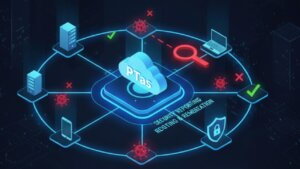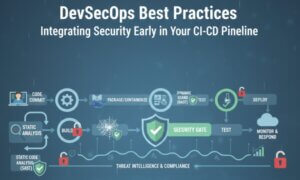Broken Object Level Authorization (BOLA) remains one of the most prevalent and dangerous security flaws in application programming interfaces. BOLA allows attackers to access, modify, or delete data objects they are not authorized to, simply by manipulating object identifiers. While manual testing is effective, it is time-consuming and not scalable. The solution? Automation.
Integrating automated BOLA detection into Continuous Integration and Continuous Deployment (CI/CD) pipelines offers a proactive approach to securing APIs throughout the development lifecycle. In this blog, we’ll explore how to automate BOLA detection, the tools you can use, and best practices to implement within your CI/CD pipeline.
-Book Your FREE Security Consultation Today!
Understanding the Need for Automation in BOLA Detection
APIs are evolving rapidly, and modern development practices like DevOps and agile promote frequent updates and rapid deployments. In such fast-paced environments, security testing must keep up. Manual security testing for BOLA vulnerabilities:
Does not scale with rapid deployments
Relies heavily on human intervention
May miss vulnerabilities introduced during frequent code changes
Automating BOLA detection ensures that every change in your codebase is evaluated for object-level authorization flaws before it reaches production.
Step-by-Step Guide to Automating BOLA Detection
-Read on How to Identify and Fix BOLA Vulnerabilities in your APIs
Step 1: Define Security Requirements
Before implementing any tools or scripts, define what constitutes BOLA in your API. Identify the endpoints that return user-specific data and require access control, such as:
/api/users/{id}/api/messages/{id}/api/orders/{id}
Work with your development and security teams to set clear access control rules.
Step 2: Static Application Security Testing (SAST)
Use SAST tools to scan your codebase for insecure coding patterns that may lead to BOLA vulnerabilities. These tools analyze source code and configuration files without executing the program.
Recommended Tools:
SonarQube
Semgrep
Checkmarx
Create custom rules or patterns to detect missing authorization checks or direct object references without validation.
Sample Semgrep Rule:
rules:
- id: insecure-object-access
pattern: |
get_object(id)
message: 'Potential BOLA vulnerability: object accessed without authorization check'
severity: WARNING
languages: [python]
Step 3: Dynamic Application Security Testing (DAST)
DAST tools simulate real-world attacks by interacting with a running application. They can test APIs by modifying object identifiers to detect authorization flaws.
Recommended Tools:
OWASP ZAP
Burp Suite Enterprise
StackHawk
You can integrate DAST tools with your CI/CD pipeline to run dynamic tests against staging environments after every build.
Step 4: API Security Scanning Tools
Use purpose-built API security scanners that understand the structure of modern APIs (REST and GraphQL). These tools can automatically detect endpoints prone to BOLA and test authorization mechanisms.
Top Tools:
Postman Security
APIsec
42Crunch
These tools often support OpenAPI and GraphQL specifications, making it easier to define and test object-level access controls.
Step 5: Automate Tests in CI/CD Pipeline
Once your tools are selected, the next step is integration. Add test stages for BOLA detection in your CI/CD configuration files.
Example with GitHub Actions:
name: BOLA Security Check
on:
push:
branches: [ main ]
jobs:
scan:
runs-on: ubuntu-latest
steps:
- name: Checkout Code
uses: actions/checkout@v2
- name: Run SAST with Semgrep
run: |
pip install semgrep
semgrep --config=path/to/config .
- name: Run DAST with OWASP ZAP
run: |
docker run -v $(pwd):/zap/wrk/:rw -t owasp/zap2docker-stable zap-baseline.py -t http://localhost:8000
Adapt this to your specific pipeline (GitLab CI, Jenkins, CircleCI, etc.) and customize scanning configurations based on your application’s endpoints.
Best Practices for Effective Automation
Test Role-Based Access: Automate tests that simulate requests from different user roles (admin, guest, regular user) to verify proper access control enforcement.
Use Mock Users: Create test accounts with varying permissions in staging environments to test for object-level authorization issues.
Secure API Documentation: Scan OpenAPI or GraphQL schema definitions for predictable object patterns (e.g., sequential IDs).
Version Control Your Security Tests: Keep your security scripts and test cases under version control so they evolve alongside your codebase.
Fail Builds on Critical Issues: Configure pipelines to block deployments if critical BOLA vulnerabilities are detected.
Challenges and How to Overcome Them
False Positives: Fine-tune scanning rules and integrate feedback loops from developers.
Performance Overhead: Run exhaustive scans in nightly builds, and critical tests on every commit.
Tool Integration: Use plugins and APIs offered by tools for seamless CI/CD integration.
Lack of Custom Rules: Customize scanning patterns specific to your application’s logic and endpoint structure.
Future of BOLA Detection in DevOps
As DevSecOps becomes the norm, more sophisticated tools leveraging AI/ML are emerging to detect anomalous access patterns in real time. Predictive scanning and behavior-driven testing will allow detection of BOLA vulnerabilities before they manifest.
Security orchestration platforms will soon be able to:
Auto-generate test cases for object access scenarios
Suggest remediations via code suggestions
Provide risk scoring per API endpoint
Conclusion
Broken Object Level Authorization continues to be a major API security concern, especially in modern CI/CD environments. Automating its detection ensures that security is built into your development pipeline from day one. By combining SAST, DAST, API scanning tools, and custom automation, teams can create robust and repeatable processes to catch and fix BOLA vulnerabilities early.
Don’t wait for an exploit in production. Shift left with automation and secure your APIs against BOLA today.
Why Businesses Trust SecureMyOrg for Comprehensive Network Security
At SecureMyOrg, we uncover and fix all possible security vulnerabilities of mobile and web, while providing solutions to mitigate risks. We are trusted by renowned companies like Yahoo, Gojek and Rippling, and with 100% client satisfaction, you’re in safe hands!







Some of the things people reach out to us for –
- Building their cybersecurity program from scratch – setting up cloud security using cost-effective tools, SIEM for alert monitoring, building policies for the company
- Vulnerability Assessment and Penetration Testing ( VAPT ) – We have certified professionals, with certifications like OSCP, CREST – CPSA & CRT, CKA and CKS
- DevSecOps consulting
- Red Teaming activity
- Regular security audits, before product release
- Full time security engineers.
Relevant Posts

AI-Powered Phishing Emails: 7 Ways to Spot and Stop Them Before They Strike
Penetration testing as a service (PTaaS) lets experts simulate real attacks to uncover vulnerabilities before hackers do. This guide explains the process, benefits, and costs, helping businesses strengthen defenses with predictable, ongoing security checks.

Why Regular Penetration Testing is Essential for Modern Companies
Penetration testing as a service (PTaaS) lets experts simulate real attacks to uncover vulnerabilities before hackers do. This guide explains the process, benefits, and costs, helping businesses strengthen defenses with predictable, ongoing security checks.

What Is Penetration Testing as a Service?
Penetration testing as a service (PTaaS) lets experts simulate real attacks to uncover vulnerabilities before hackers do. This guide explains the process, benefits, and costs, helping businesses strengthen defenses with predictable, ongoing security checks.

How To Inspect Encrypted Traffic Without Breaking Privacy
Network administrators face a challenge: securing systems while respecting privacy. This guide explains how to inspect encrypted traffic without breaking privacy using metadata, anomaly detection, and machine learning ensuring visibility, compliance, and trust.

How to Audit Infrastructure as Code (IaC) for Security Vulnerabilities
Discover how to audit Infrastructure as Code (IaC) for security vulnerabilities with this practical guide. Learn to scan IaC files using tools like Checkov, fix issues like exposed resources, and integrate audits into CI/CD pipelines. Protect your cloud systems from misconfigurations and ensure compliance with clear, actionable steps.

DevSecOps Best Practices: Integrating Security Early in Your CI/CD Pipeline
This article provides a practical guide to embedding security into every stage of your CI/CD pipeline. Learn core DevSecOps best practices like SAST, DAST, dependency scanning, secrets management, and compliance automation to catch vulnerabilities early, foster a culture of shared ownership, and build a secure-by-design development process that accelerates release cycles.



